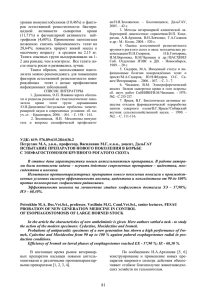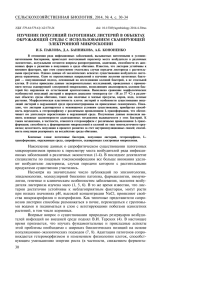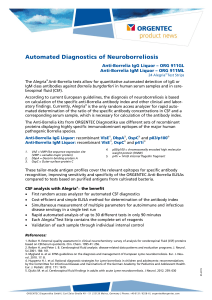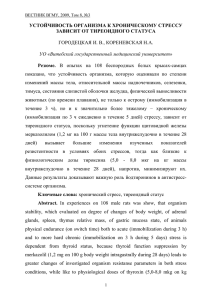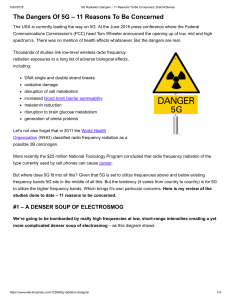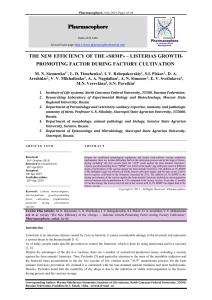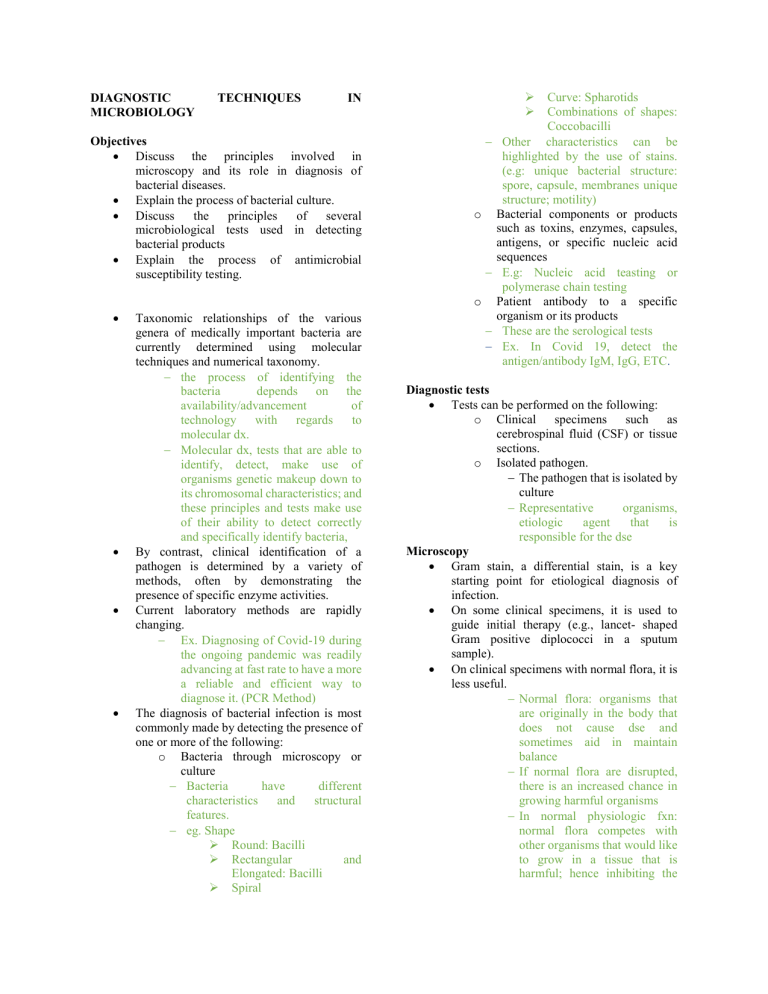
DIAGNOSTIC MICROBIOLOGY TECHNIQUES IN Objectives Discuss the principles involved in microscopy and its role in diagnosis of bacterial diseases. Explain the process of bacterial culture. Discuss the principles of several microbiological tests used in detecting bacterial products Explain the process of antimicrobial susceptibility testing. o o Taxonomic relationships of the various genera of medically important bacteria are currently determined using molecular techniques and numerical taxonomy. the process of identifying the bacteria depends on the availability/advancement of technology with regards to molecular dx. Molecular dx, tests that are able to identify, detect, make use of organisms genetic makeup down to its chromosomal characteristics; and these principles and tests make use of their ability to detect correctly and specifically identify bacteria, By contrast, clinical identification of a pathogen is determined by a variety of methods, often by demonstrating the presence of specific enzyme activities. Current laboratory methods are rapidly changing. Ex. Diagnosing of Covid-19 during the ongoing pandemic was readily advancing at fast rate to have a more a reliable and efficient way to diagnose it. (PCR Method) The diagnosis of bacterial infection is most commonly made by detecting the presence of one or more of the following: o Bacteria through microscopy or culture Bacteria have different characteristics and structural features. eg. Shape Round: Bacilli Rectangular and Elongated: Bacilli Spiral Curve: Spharotids Combinations of shapes: Coccobacilli Other characteristics can be highlighted by the use of stains. (e.g: unique bacterial structure: spore, capsule, membranes unique structure; motility) Bacterial components or products such as toxins, enzymes, capsules, antigens, or specific nucleic acid sequences E.g: Nucleic acid teasting or polymerase chain testing Patient antibody to a specific organism or its products These are the serological tests Ex. In Covid 19, detect the antigen/antibody IgM, IgG, ETC. Diagnostic tests Tests can be performed on the following: o Clinical specimens such as cerebrospinal fluid (CSF) or tissue sections. o Isolated pathogen. The pathogen that is isolated by culture Representative organisms, etiologic agent that is responsible for the dse Microscopy Gram stain, a differential stain, is a key starting point for etiological diagnosis of infection. On some clinical specimens, it is used to guide initial therapy (e.g., lancet- shaped Gram positive diplococci in a sputum sample). On clinical specimens with normal flora, it is less useful. Normal flora: organisms that are originally in the body that does not cause dse and sometimes aid in maintain balance If normal flora are disrupted, there is an increased chance in growing harmful organisms In normal physiologic fxn: normal flora competes with other organisms that would like to grow in a tissue that is harmful; hence inhibiting the growth of these harmful organisms Gram staining is more useful to pathogens On the isolated bacterial culture, the source of the isolate, Gram reaction, and oxidase or catalase test results guide the selection of additional identification tests and antibiotic susceptibilities. Gram-positive bacteria are purple. Gram-negative bacteria are red/pink because they lose the purple dye complex and stain pink/red with the counterstain. NEED TO REMEMBER!!!!!!! GRAM POSITIVE GRAM NEGATIVE Thick peptidoglycan Has outer membrance layer which has lipopolysaccharides: it can elicit an immune response and an important virulence factor Acid-fast stain. This stain distinguishes mycobacteria, all of which are acid-fast (red), from all other bacteria, all of which are not acid-fast (blue). Additionally: o Nocardia are partially acid-fast: stains show red and blue clusters of the same bacterium on the same slide or vary from slide to slide. o Parasitic oocysts of Cryptosporidium, Cyclospora, and Isopora are acid-fast. When the smear is stained with carbol fuchsin (piink to red stain), it solubilizes the lipoidal material present in the Mycobacterial cell wall but by the application of heat, carbol fuchsin further penetrates through lipoidal wall and enters into cytoplasm. Then after all cell appears red. o Then the smear is decolorized with decolorizing agent (3% HCL in 95% alcohol) but the acid fast cells are resistant due to the presence of large amount of lipoidal material in their cell wall which prevents the penetration of decolorizing solution. The non-acid fast organism lack the lipoidal material in their cell wall due to which they are easily decolorized, leaving the cells colorless. Then the smear is stained with counterstain, methylene blue. Only decolorized cells absorb the counter stain and take its color and appears blue while acid-fast cells retain the red color. Wet mounts are used for specific specimens such as unspun urine or for motility. Dark field microscopy is useful for spirochetes too thin to be seen in a Gram stain or for wet mounts used for motility. Fluorescent microscopy is used to examine cultured isolates. It is also used directly on clinical specimens. Fluorochrome dye methods include auramine-rhodamine dyes that bind nonspecifically to waxy cell wall components of both Mycobacterium and Nocardia. o These stains are easier to read than an acid-fast stain because fluorescent dyes light up the bacteria on the black background without interference from the specimen. The auramine-rhodamine fluorescent dye technique is actually a more sensitive screening technique than an acid-fast stain because the bacteria are easier to spot. The fluorochrome dyes are not specific for mycobacteria because antibodies are not involved in the binding of the dye to the bacteria. o An acid-fast stain must be performed to confirm the presence of mycobacteria. Fluorochrome stain The auramine binds nonspecifically to the waxy mycobacterial cell well. Because there is no antibody involved in this binding, this is not a specific stain, but it is a sensitive screening test for sputum samples and is easy to read because of the contrast of the bound dye with everything else dark. A positive fluorochrome stain is always confirmed by an acid-fast stain or a mycobacterial fluorescent antibody stain. Fluorescent antibody (FA) stains may be specific to a genus or species depending on specificity of the primary antibody Direct fluorescent antibody (DFA) uses fluorescent-labeled antibodies that are specific to various microbes. o Because a different fluorescent antibody must be made for each agent, DFAs are commercially available only for common organisms. Indirect fluorescent antibody (IDFA) uses unlabeled, known antibodies that bind to bacterial antigens. o A fluorescent antibody that detects the bound antibody is applied, highlighting any antibody bound to the organism. Culture A complex process that requires that specimens be properly obtained and transported and then grown on appropriate media under the correct conditions. Partial immunity, presence of active white cells (in blood cultures), or partial antibiotic treatment may interfere with growth. 1. The area from which the specimen is obtained influences interpretation of results. a.If a specimen is obtained from a normally sterile area (e.g.,CSF) using aseptic technique, the finding of any microbes in the specimen is significant. If a specimen is obtained from a normally sterile area but passes through tissue with normal flora, specific specimen guidelines are used to evaluate the quality of the specimen and to interpret the results. Examples of these specimens are sputa or urine taken by the clean catch midstream urine method. • With ‘‘sputum,’’ the finding of many epithelial cells and lack of PMNs suggests that the specimen is saliva rather than material from the lungs. With urine, quantitation guidelines suggest whether the patient has an infection or has normal levels of normal flora contaminating the specimen. The finding of a specific pathogen that is not part of the normal flora is diagnostic of infection with that agent. If a specimen is obtained from an area with normal flora such as skin or mucous membranes, interpretation involves isolating pathogens or finding overgrowth of normal flora. • The method and medium of transport of the specimen are often critical, especially if it is transported to a reference lab. • Potentially anaerobic specimens such as abscess material must be transported anaerobically. • Some organisms are sensitive to cold or drying. Proper culture medium and growth conditions influence growth. A rich medium, often with blood, is commonly used as one isolation medium for most specimens. Hemolysis on blood agar may be used identifying bacterial species (1) Alpha-hemolysins produce incomplete lysis, with green pigment surrounding the colony. (2) Beta-hemolysins produce total hemolysis and release of hemoglobin and a clear area around the colony. (3) Bacteria producing no hemolysis and are called gamma-hemolytic or nonhemolytic. • b. Some specific media (including blood agar) help differentiate groups of organisms directly on the plate. Examples are Hektoen and MacConkey agars that distinguish lactose fermenters from nonfermenters • Fastidious bacteria are those with complex nutritional requirements. These bacteria will not grow on standard blood agar and require special specific media. • The following are media commonly used to grow fastidious bacteria: (1) Chocolate agar (agar with lysed red blood cells). (a) This medium is used for both Haemophilus spp. and Neisseria spp., both of which are nonhemolytic but require free hemoglobin (b) Thayer-Martin or New York City agars are used to grow Neisseria that have been obtained from body areas with competing normal flora (any mucosa). Both are chocolate agars that contain antibiotics to prevent growth of the bacteria and yeasts that are part of the normal mucosal flora. Often genetic probes are used instead of cultures for diagnosis of gonorrhea. (2) Regan-Lowe and Bordet-Gengou agars. (a) These media are used for culture of Bordetella pertussis. (b) Rapid nonculture methods are replacing culture because it is difficult to culture B. pertussis either from a vaccinated person or after the early paroxysmal stage in both vaccinated and nonvaccinated individuals. Thiosulfate-citrate-bile salts-sucrose. Thiosulfate-citrate-bile saltssucrose (TCBS) is an alkaline medium used to grow Vibrio cholerae. (Just learn the initials and that TCBS is an alkaline media for V. cholerae.) (Buffered) charcoal-yeast extract (BCYE) agar is used to grow Legionella. It contains needed iron and cysteine plus charcoal. Lowenstein-Jensen agar. • Lowenstein-Jensen (L-J) agar contains egg yolk that provides the necessary lipids fo mycobacteria. • It is being replaced with high lipid broth cultures specifically designed for mycobacteria, allowing faster growth. Detection of microbial products • Antigen detection requires specific antibodies and may be done by direct or indirect fluorescent microscopy or by enzyme-linked immunoassay (ELISA). • Tests demonstrating specific enzymes or toxin activities. a. Nagler test for Clostridium perfringens alpha-toxin (a lecithinase): this test uses a lecithin containing agar to detect lecithinase activity. > One side of the plate has an antibody to the alpha toxin that neutralizes its activity. > The test result is positive if there is change around the growth on the side without antitoxin and no change in the media on the side containing the antitoxin since the antitoxin will inactivate the enzyme. Hemolysis on blood agar Growth on media with one major carbohydrate source. (1) Growth in broths where there is only one carbohydrate. (2) MacConkey agar: this agar has peptone and lactose; it supports the growth of all Enterobacteriaceae but only those fermenting the lactose will cause a color change. (It also contain bile salts and crystal violet to inhibit the growth of non enteric organisms and Gram-positive organisms.) Growth in broths with specific substrates for detection of specific activities: these tests are the mainstay of commonly used automated identification systems. Rapid enzyme tests detect the presence of the following enzymes: Catalase breaks down hydrogen peroxide. This test is used to differentiate the genus Staphylococcus (catalase-positive) from Streptococcus (catalasenegative). In general,many anaerobes (and some microaerophiles) do not make catalase. Oxidase (cytochrome-C oxidase) is produced by most Gram-negative bacteria but not by members of the Enterobacteriaceae. Nitrate reductase (urine dipstick tests): this test is performed directly on urine. > Escherichia coli and other enterobacteria produce nitrate reductase; this test requires that the bacteria remain in contact with the urine for a sufficient time. >Staphylococcus saprophyticus does not produce nitrate reductase. • Growth under specific conditions can be used to identify certain metabolic features of microbes, such as whether it is an aerobe or anaerobe. • Suspected Campylobacter cultures are grown in incubators at 42C under microaerophilic conditions. • Thioglycollate broth is a medium with reducing power that develops an oxygen gradient. They are carefully stab inoculated the full length. If an organism grows only at the top of the medium, the isolate is an obligate aerobe. If an organism grows throughout the m but grows more heavily at the top, it is a facultative anaerobe. If an organism grows a little way down but not on the surface, it is a microaerophile. If an organism only grows on the bottom, it is an obligate anaerobe. • Commercial test systems are generally designed to identify a clinical isolate and determine antibiotic susceptibility simultaneously. The general steps used in these systems are as follows: Bacterial isolates are grown from the patient specimen. Gram-stain results (often along with catalase or oxidase tests) are used to select the appropriate identification tests (a series of tests identifying specific enzyme activities such as carbohydrate utilization, urease, etc.). The plates also contain wells with antimicrobials for susceptibility determination. Plates are read by machine; results are given as the probability that the isolate is the identified organism and gives minimal inhibitory concentrations for the tested antibiotics. • Nucleic acid detection is done with gene probes with or without amplification. Newer techniques may be done directly on clinical specimens as well as cultured growth. Amplification methods include polymerase chain reaction (PCR), reverse transcriptase PCR (RT-PCR), and quantitative real-time PCR (utilizing fluorescent dyes or probes to measure double-stranded DNA). Fluorescent in situ hybridization (FISH) tests are becoming available for clinical diagnostic use for some organisms or toxins and can be used on tissue sections, specimens such as sputum, or on gels. MALDI-TOF MS MALDI-TOF MS is an analytical technique in which particles are ionized, separated according to their mass-to-charge ratio, and measured by determining the time it takes for the ions to travel to a detector at the end of a time-of-flight tube. The resulting spectrum, with mass-to- charge values along the x-axis and intensity along the y-axis, is compared to a database of spectra from known organisms. Detection of immune response to a specific pathogen Detection of patient antibody demonstrates current or previous exposure to a pathogen. Positive titers (levels) are expressed as the highest dilution giving a positive test so that a titer written as 1/64 is much higher than a titer of 1/4. Titers may also be written as 1:4. High immunoglobulin M(IgM) titers suggest recent infection or exposure. High IgG titers usually indicate older infection or exposure. A positive skin test (e.g., tuberculin skin test) in a person who is immunocompetent demonstrates only past or current exposure and, unlike serology, cannot differentiate between the two. These tests therefore have limited utility. Determination of antimicrobial susceptibility • Susceptibility testing is done by many methods depending on the organism 1. Gene probes (generally with amplification methods) may be used to determine if an organism carries a gene for drug resistance. 2. Rapid tests are performed on an isolate mixed with a special substrate such as a chromogenic (colored) beta-lactam. • If the beta-lactam ring is broken by lactamase, it leads to a color change. 3. Rapid growth detection systems (such as for Mycobacterium tuberculosis) use realtime PCR to detect growth. • These tests are performed in a series of ‘‘tubes’’ in which some contain antimicrobials. Growth can be assessed in the presence or absence of specific antimicrobials (at appropriate levels). • Minimal inhibitory concentrations tests are used to determine the minimal inhibitory concentration (MIC) for a particular drug that inhibits the growth of a bacterium. Microtiter plates that are used with series of tests to identify an organism also have series of wells in which multiple appropriate antibiotics can be tested at a range of concentrations achievable in the body. A Gram stain is performed prior to testing to determine the appropriate antibiotics that should be tested. The lowest concentration of each drug that inhibits growth is MIC for that drug. Minimal bacteriocidal concentrations (MBCs) are usually determined by extrapolation. • Some antimicrobials are only inhibitory. Bacteriocidal drugs that kill bacteria are used in immunocompromised patients whose immune systems are not able to assist in eliminating the bacteria. • Agar gel diffusion plates (Kirby-Bauer) use paper disks containing standard concentrations of dehydrated antibiotics. An agar medium in a petri dish is spread with the patient’s isolate. A dispenser drops the appropriate antibiotic disks onto the surface. Antibiotics hydrate and diffuse out. The plates are incubated, generally overnight, and zones of growth inhibition are then measured and interpreted as to whether the organism is sensitive, resistant, or has intermediate susceptibility to the drug. These tests are qualitative, not quantitative. • E-tests are also agar diffusion antibiotic susceptibility tests but are improved through the incorporation of a small plastic ‘‘ruler’’ that correlates the zone of inhibition with MIC data. a. The values on the scale have been determined by research testing large numbers of bacterial strains and correlating the zones of inhibition for that antibiotic for the same organism with the MIC values. b. The test produces an elliptical zone of growth inhibition (thus the name E- test) and is semiquantitative because the zone data was matched with the specific MIC data.


